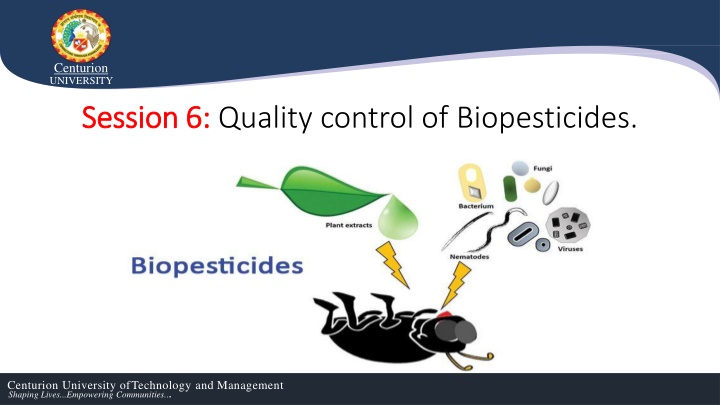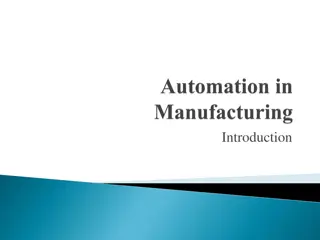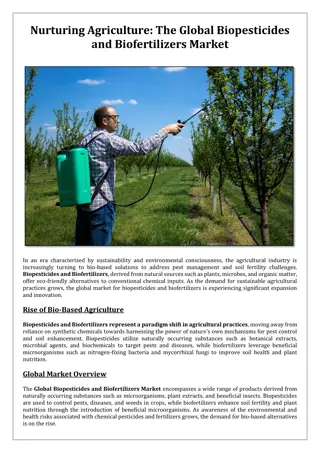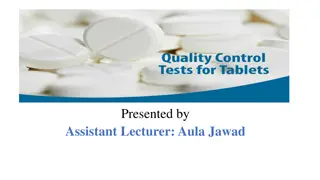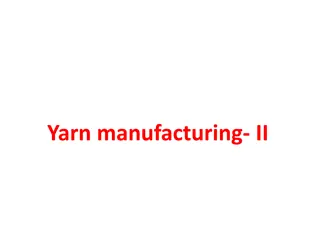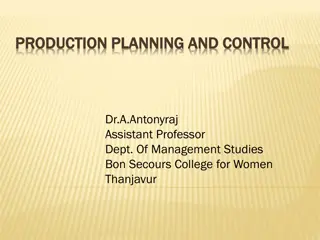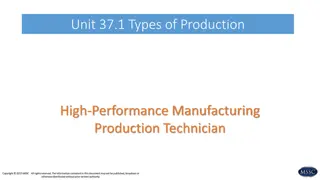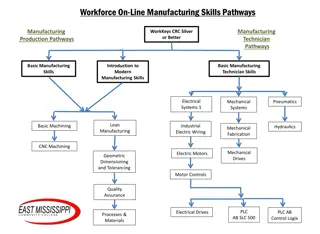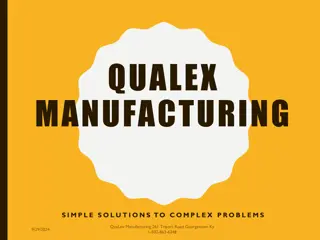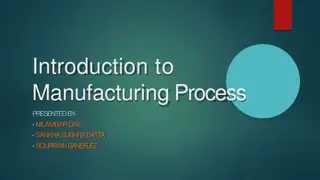Importance of Quality Control in Biopesticides Manufacturing
Quality control in biopesticides production is crucial for ensuring reliable and effective products. The current lack of standardized protocols poses challenges for manufacturers worldwide, leading to disparities in product quality. To promote the adoption of microbial control agents, it is essential to establish consistent quality control procedures to enhance efficacy and acceptance among farmers. Safety testing and regulatory guidelines play a key role in ensuring the effectiveness and safety of biopesticides.
Download Presentation

Please find below an Image/Link to download the presentation.
The content on the website is provided AS IS for your information and personal use only. It may not be sold, licensed, or shared on other websites without obtaining consent from the author.If you encounter any issues during the download, it is possible that the publisher has removed the file from their server.
You are allowed to download the files provided on this website for personal or commercial use, subject to the condition that they are used lawfully. All files are the property of their respective owners.
The content on the website is provided AS IS for your information and personal use only. It may not be sold, licensed, or shared on other websites without obtaining consent from the author.
E N D
Presentation Transcript
Centurion UNIVERSITY Session 6: Session 6: Quality control of Biopesticides. Centurion University ofTechnology and Management Shaping Lives...Empowering Communities...
Centurion UNIVERSITY Quality control Why? Why? In promoting the adoption of microbial control agents by farmers, the reliability of the product is a crucial issue in ensuring acceptance and sustained use. The issue of erratic performance of fungal and viral biocontrol agents has been recognized as a significant factor in the limited successful commercialization of these agents. It has been widely perceived that fungal and viral control agents have not to date achieved a level of efficacy comparable with that of their chemical counterparts, or with that of the leading bacterial agent, Bacillus thuringiensis. Many of the products that have been placed on the market have been characterized as weak products with poor efficacy and questionable quality control . Centurion University ofTechnology and Management Shaping Lives...Empowering Communities...
Centurion UNIVERSITY Quality control Why? Why? To be effective, microbial control agents based upon fungi and baculoviruses (BV) depend on the successful completion of a complex infection process by the pathogen. It is therefore more difficult to monitor the quality of microbial control agents than with chemical insecticidal products whose active ingredients are simple toxic chemicals. A biocontrol product that has an infectious agent as the active ingredient is the result of a complex biotic process whether manufactured using in vitro or in vivo technology. The quality assessment procedure of the final product needs, therefore, to extend back to all levels of the production process including any insects or cell lines used to multiply the agent. Centurion University ofTechnology and Management Shaping Lives...Empowering Communities...
Centurion UNIVERSITY Present Scenario Present Scenario Given the crucial role of quality control in fungal and viral production, it is a matter of concern that standardized protocols for the quality control of these products are not yet widely agreed or accepted. This is the case in developed and developing countries alike. Even where regulatory procedures for registration of fungal and viral control agents are enforced, no standardized guidelines for quality control procedures are available. Manufacturers of these microbial control products are therefore required to develop their own quality control procedures, which has resulted in a disparity in standards between manufacturers of similar products. Centurion University ofTechnology and Management Shaping Lives...Empowering Communities...
Centurion UNIVERSITY Present Scenario Present Scenario In general, the organisms selected for pest control are specifically active against the target pest. Therefore, the risk of affecting non-target organisms, including humans, is presumed to be relatively low. However, it is necessary to carry out some standardized safety tests, supporting the presumption and proof of efficacy, before allowing large scale use of biopesticides. Accordingly, guidelines have been laid down by the Food and Agriculture Organization of The United Nations; various countries have also framed their own guidelines for registration of biopesticides. Centurion University ofTechnology and Management Shaping Lives...Empowering Communities...
Centurion UNIVERSITY Quality control of Biopesticides in India Quality control of Biopesticides in India The insecticides act, 1968 is An Act to regulate the import, manufacture, sale, transport, distribution and use of insecticides with a view to prevent risk to human beings or animals, and for matters connected therewith. According to Insecticides Act 1968, central government implements registration and quality control whereas state governments takes care of manufacturing licences, sale permit/license, quality control and use. Registration committee (RC) is constituted under section 5 of insecticides act, 1968. Centurion University ofTechnology and Management Shaping Lives...Empowering Communities...
Centurion UNIVERSITY STATUTORY BODIES UNDER THE INSECTICIDES ACT CENTRAL LEVEL STATE LEVEL Central insecticides board Licensing officers Registration committee Insecticide inspectors Central insecticides laboratory Insecticide analyst Regional pesticides testing laboratories Pesticide poisoning reporting Centurion University ofTechnology and Management Shaping Lives...Empowering Communities...
Centurion UNIVERSITY Data Requirements for Registration of Biopesticides Chemistry Bio-efficacy Toxicity Packaging and Labelling Centurion University ofTechnology and Management Shaping Lives...Empowering Communities...
Centurion UNIVERSITY Chemistry & Biological characteristics Systemic name, strain Detail composition Test procedure Specifications Contaminants Process of manufacture Shelf-life Coding (in case of formulation) Centurion University ofTechnology and Management Shaping Lives...Empowering Communities...
Centurion UNIVERSITY Bio-efficacy Laboratory Tests. Field Trials with proposed formulation (ICAR, SAU, CSIR, ICMR) Phytotoxicity Effect on non-target organisms (Two season/Two year data on natural parasites and predators) Centurion University ofTechnology and Management Shaping Lives...Empowering Communities...
Centurion UNIVERSITY Toxicity Single exposure studies Skin and mucous membrane irritation Toxicity to birds, fish, honey bees, silk worm, earthworm with formulation only Centurion University ofTechnology and Management Shaping Lives...Empowering Communities...
Centurion UNIVERSITY Packaging & Labeling Type of packaging Manner of packaging Container contents compatibility Labels and leaflets Instruction for storage anduse Disposal of empty containers Centurion University ofTechnology and Management Shaping Lives...Empowering Communities...
Centurion UNIVERSITY Data Requirements for Neem based Pesticides Chemistry Bio-efficacy Name of part of plant Bio-effectiveness Process of manufacture Phytotoxicity Chemical identity of Compatibility with other ingredients chemicals Physiochemical properties Label information: Purpose of Specifications manufacture, direction for use Method of analysis (dosage), time of application, Analytical test report waiting period, application Shelf life claim/data equipments Centurion University ofTechnology and Management Shaping Lives...Empowering Communities...
Centurion UNIVERSITY Toxicity Packaging & Labeling Acute toxicity studies (except Type of packaging inhalation) Manner of packaging Skin & mucous membrane irritation Container contents compatibility Neurobehavioral toxicity Labels and leaflets Mutagenicity Instruction for storage and use Reproduction toxicity Disposal of empty containers Carcinogenicity Health monitoring studies in applicators Centurion University ofTechnology and Management Shaping Lives...Empowering Communities...
Centurion UNIVERSITY Centurion University ofTechnology and Management Shaping Lives...Empowering Communities...
